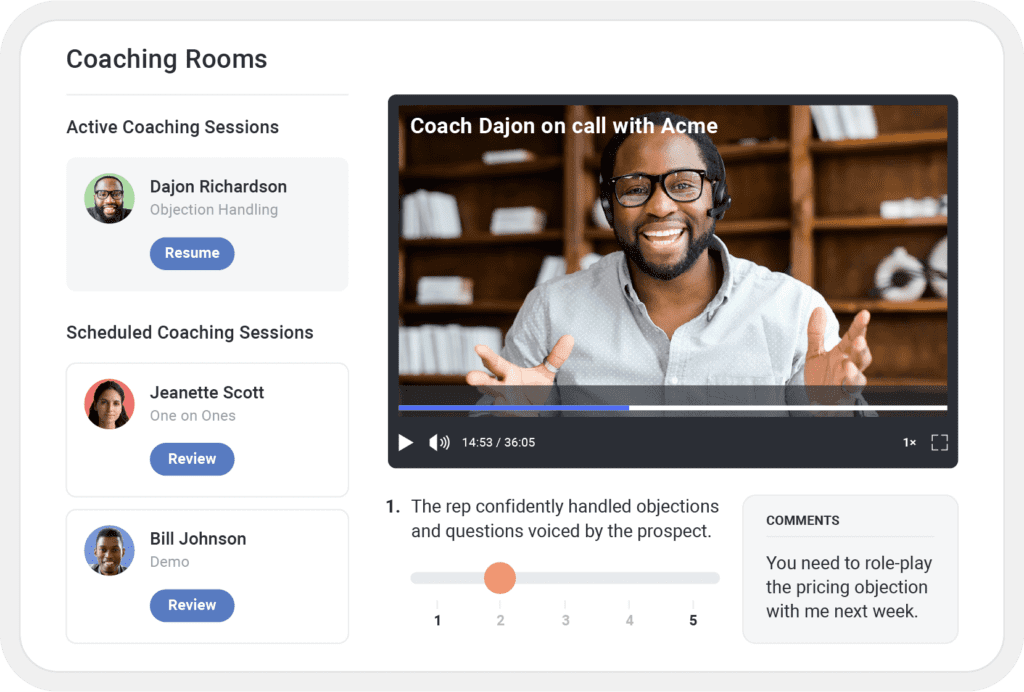Every sales organization aims to close more deals and grow revenue. Of course, sales reps play a critical role in achieving these goals. But often, they’re ill-equipped to guide deals to the finish line.
Each prospective customer comes with a unique set of needs and challenges. All too often, sales reps spend time developing a unique sales strategy for each prospect based on what they think will work. In other words, these sales reps attempt to “reinvent the wheel” each and every time.
A better approach is for the sales team to determine what actually works with top sales reps – and then equip the entire sales team with those proven strategies and best practices. That’s where sales playbooks come in.
In this post, we’ll explore what a playbook is, what it includes, how you can build one that works well for your sales team. We’ll also cover some of the key challenges organizations face when creating and implementing a sales playbook.
What is a sales playbook?
Before we dive into how to create a sales playbook, let’s first align on what a sales playbook is.
A sales playbook is a guide that outlines your organization’s sales strategies, processes, procedures, and best practices. Sales playbooks aren’t simply a collection of generic tips and practices. Instead, a sales playbook outlines strategies, processes, and techniques that are proven to work at that specific organization.
There are many benefits of a sales playbook. But at the end of the day, a sales playbook is a great resource for engaging any buyer at any point in the sales cycle. When sellers employ the strategies in the playbook, they can close more deals, hit quota, and grow revenue.
A sales playbook is a powerful tool. However, sales organizations must deliver training and ongoing learning opportunities to ensure sellers master the strategies outlined in the playbook. In addition, sales managers must deliver sales coaching to help sellers understand how to use the strategies and best practices in the sales playbook.

What is included in a sales playbook?
There’s no single sales playbook that works for all companies. Instead, sales playbooks vary from company to company, depending on factors including industry and audience (among others).
However, there are some common elements you’ll find across most sales playbook templates. Let’s take a closer look at a few of those B2B sales playbook components.
Company overview
This section of the sales playbook includes high-level information about your company, its goals, and the role of sellers in achieving those goals. That information includes the organization’s:
- Mission
- Values
- Strategy
This section also includes an organizational chart to help sellers understand who reports to whom – and how the organization fits together. There may also be a section in the enterprise sales playbook that outlines the roles and responsibilities of each individual on the sales team.
Product information
Successful sellers must become product experts. This section of the B2B sales playbook includes details about each of your product or service offerings – including pricing. Here, sellers can better understand:
- What you sell
- What your products and services do
- How your products and services help buyers solve challenges and address pain points
- How much your products and services cost
This section should also include details and pricing for any packages your company offers.
Compensation structure
HR should communicate a rep’s compensation structure during the hiring process. However, it’s also important to incorporate information about compensation structure in your sales playbook. Be clear and transparent. This will help sellers understand what to expect and eliminate confusion down the road.
Sales methodology
In the world of sales, there are myriad sales methodologies. Some of those methodologies include:
- Solution selling
- Consultative selling
- Product-based selling
An organization must identify the sales methodology that best aligns with its goals and values.
Be sure to outline your organization’s chosen methodology in your enterprise sales playbook. This will serve as a framework for every deal your sellers face. In addition, you may want to include information about why this methodology was chosen.
Sales process
The sales process section should take up a good portion of your B2B sales playbook. Essentially, it explores each step sellers must take during the sales process – from identifying prospects to closing the deal. This section is a key resource for helping sellers understand what they need to do to be successful at each stage of the selling cycle.
Ideal customer profiles
Your reps have limited time. As such, you want them to spend their time with good-fit prospects.
Your ideal customer profiles outline the key characteristics of a prospect that’s a good fit for your offerings. The ICP can include information such as:
- Company size
- Industry
- Geographic location
- Job title
- Challenges
- Goals
Of course, a rep may engage with multiple personas during the sales cycle. For example, a rep selling sales enablement software might interact with sales, marketing, and sales enablement professionals. Including these personas in your sales playbook can help your sellers understand who these people are and what matters to them.
Sales plays
This critical section of the sales playbook provides sellers to follow in a specific sales scenario – whether it be lead qualification or negotiation. Remember: sales plays shouldn’t be based on hunches. Instead, they should be rooted in practices that are proven to work at your organization.
Sales messaging
It’s important to ensure sellers are aligned on company messaging. This section of the B2B sales playbook helps sellers know what to say in certain circumstances. It might include messaging for:
- Prospecting via phone or email
- Delivering an elevator pitch
- Handling objections
- Asking questions
- Closing deals
KPIs
Sellers must have a good understanding of what’s expected of them. That way, they can prioritize their time accordingly. Be specific about the seller’s key performance indicators (KPIs) and keep them in the loop if those KPIs change.
Additional resources
Most likely, your sellers have plenty of additional resources at their disposal to help them move deals forward. For example, they may have access to internal sources, including:
- Training
- Battle cards
- Sales decks
They may also have access to customer-facing content, such as:
- Sales sheets
- Case studies
- Product presentations
This section of your enterprise sales playbook should outline what resources are available to sellers and where they can find these resources.
How to create a sales playbook
Sales playbooks are unique to each organization. So it’s not as simple as running a Google search for “sales playbook” – and then adopting one of the top results as your own.
So, how can you go about building a sales playbook that works for your organization?
Some organizations start with a sales playbook template. In addition, there are some key sales playbook best practices to keep in mind.
1. Form your sales playbook team
A sales playbook can’t be a single-person effort. Instead, it requires cross-functional collaboration. Typically, you need to include representatives from the following groups:
- Sales leadership
- Top sales reps
- Marketing
- HR
- Product development
- Executive team
While this is a collaborative effort, one person should be tapped to lead the project. This person will be responsible for coordinating the entire process and ensuring the team develops an effective sales playbook.
2. Do your research
Once you’ve established your sales playbook team, it’s time to do an audit of your organization’s current processes. During this stage, your goal is to gain a deep understanding of what processes, strategies, and resources are currently being used in the field – and how (or whether) they’re driving reps’ success. You’ll also want to identify common challenges and pain points.
Your sales reps are a great source of information. After all, they’re the ones in the field interacting with buyers all day. Top sellers can convey what they do that sets them apart from the rest. In addition, sellers of all experience levels can share insights on their processes and key challenges.
3. Determine your sales methodology
A sales methodology sets the tone for how your sellers interact with buyers. If you haven’t already, now is the time to determine which sales methodology fits best for your organization’s goals and values. Be sure to include details on your chosen sales methodology in your sales playbook.
4. Map the sales process
In order to create an effective sales playbook, it’s key to understand how both buyers and sellers navigate the sales process.
Based on your research, map the sales process – both from a buyer’s and a seller’s perspective. Be sure to define the common needs and pain points at each point in the purchase journey.
Then, identify which tactics and techniques are most effective for moving buyers from one stage of the sales process to the next.
5. Design sales plays based on what works for your top sellers
Sales plays are a key component of a sales playbook. But those sales plays shouldn’t be based on what should work. Instead, they must be based on strategies and techniques that are proven to work. Your top sellers are a great source of information for what works well.
6. Create your sales playbook
Once you’ve done all the background work, it’s time to write and format your sales playbook.
One common question is, “How long should a sales playbook be?” There’s no easy answer. It’s important to include all necessary information. But don’t be needlessly verbose. Sellers are more likely to read the entire sales playbook if it’s clear and concise.
Regardless of length, be sure to include a table of contents. While sellers should read the playbook in its entirety, they will also use it as a reference guide. A table of contents helps them easily find exactly what they’re looking for.
In addition, be sure to consider format. Some organizations use printed sales playbooks. However, this approach isn’t usually effective. A better approach is to ensure sellers can digitally access the sales playbook – and all supporting resources – within a single platform. With such a platform, you can also make updates digitally. That means sellers always have access to the latest and greatest version of the sales playbook.
7. Revisit your sales playbook often
In the world of business, change is constant. Markets evolve. Product and service offerings change. New sales techniques and tactics come to light that help sellers successfully close more deals. Your sales playbook must evolve to keep up.
Be sure to track usage of the playbook. In addition, ask for feedback. This will help you understand what’s working – and what’s not. Then, you can use those insights to optimize your sales playbook on a regular basis.
Key challenges when creating and implementing a sales playbook
A sales playbook serves as a guide to help sellers successfully navigate deals. As such, it’s well worth the time and effort required to create an effective sales playbook.
However, there are some challenges organizations face when creating and implementing a sales playbook. Let’s take a look at some of the common challenges.
Change can be difficult in all facets of life – including business. When you introduce a sales playbook, this is a change for your sellers. Some sellers and sales managers will resist this change
The market is always in flux. It’s important to ensure your sales playbook serves your sellers today – and in the future. However, it can be challenging to ensure your sales playbook always reflects these constant changes in the market.
Ongoing feedback is key to creating an effective sales playbook. Early on in the process, sales feedback ensures you understand what techniques and strategies are (and aren’t) working in the field. You’ll also have sellers who share feedback after the sales playbook has been created and distributed.
It can be challenging to collect feedback in a way that represents all sellers. In addition, it’s tough to distill this feedback into actionable insights you can use to improve and enhance your sales playbook.
The most effective sales playbooks are those that are revised regularly to reflect changes and feedback. However, regular updates increase the likelihood that sellers are using an outdated version of the sales playbook. This is especially true if you use printed sales playbooks or PDF versions that are distributed via email.
Using a revenue productivity platform can help. Your sales playbook – as well as all accompanying training and resources – are all housed in a single platform. It’s easy to make changes to the sales playbook and you can be sure your sellers are always turning to the most up-to-date version of the sales playbook.
Elevate your sales performance using sales playbooks
Sellers have a limited number of hours in the day. There’s no need to reinvent the wheel for each deal – especially when there are strategies that are proven to work.
Sales playbooks are a powerful tool for new and veteran sellers alike. Sales playbooks – when they’re done well – equip sales reps with proven tools and strategies to move any deal forward. When sellers have access to a proven formula, they’re more likely to close deals and drive revenue growth.
Printed and PDF playbooks aren’t the best approach as they quickly become outdated. A better approach is to create your sales playbook with a revenue productivity platform like Mindtickle. With Mindtickle, your sellers always have access to the sales training, enablement, and call insights they need to close more deals – all within a single platform.
Build a better selling team
Ready to see how Mindtickle empowers sales teams to identify and scale best practices that lead to better outcomes?
Request a Demo






